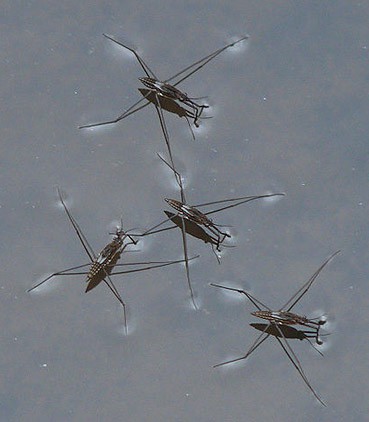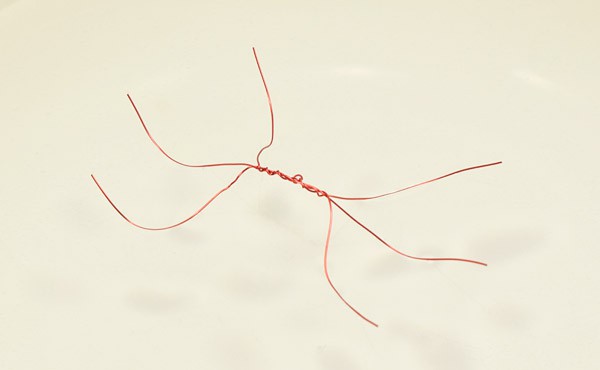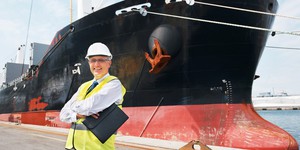Log In
Summary
Areas of Science
Difficulty
Time Required
Very Short (≤ 1 day)
Credits
Ben Finio, PhD, Science Buddies

*Note:
For this science project you will need to develop your own experimental procedure. Use the information in the summary tab as a starting place. If you would like to discuss your ideas or need help troubleshooting, use the Ask An Expert forum. Our Experts won't do the work for you, but they will make suggestions and offer guidance if you come to them with specific questions.
If you want a Project Idea with full instructions, please pick one without an asterisk (*) at the end of the title.
If you want a Project Idea with full instructions, please pick one without an asterisk (*) at the end of the title.
Abstract
Water striders (also called water bugs, pond skippers, etc.) are insects that can hop around on the surface of water (Figure 1). Unlike boats or other floating objects that are partially submerged and held up by the resulting buoyant force, water striders are held up by surface tension.
Figure 1. Water striders (image credit Isaka Yoji).
You can build your own water striders using thin wire (Figure 2 and following video). Do some background research about surface tension, and experiment with how different variables affect the performance of your water strider. What happens if you change the diameter of the wire, the length of the legs, or the number of legs? For advanced students, can you do calculations that determine how much weight the water strider should be able to support based on the size of the legs? How do these calculations compare to your experimental results?
 Image Credit: Ben Finio, Science Buddies / Science Buddies
Image Credit: Ben Finio, Science Buddies / Science Buddies
Figure 2. Water strider built from copper wire.
Bibliography
- The National Wildlife Federation (n.d.). Water Striders. Retrieved May 30, 2018.
- Nave, R. (n.d.). Surface Tension. Hyperphysics. Retrieved May 30, 2018.
Ask an Expert
Do you have specific questions about your science project? Our team of volunteer scientists can help. Our Experts won't do the work for you, but they will make suggestions, offer guidance, and help you troubleshoot.
Global Connections
The United Nations Sustainable Development Goals (UNSDGs) are a blueprint to achieve a better and more sustainable future for all.
This project explores topics key to Life on Land: Sustainably manage forests, combat desertification, halt and reverse land degradation, halt biodiversity loss.
Careers
If you like this project, you might enjoy exploring these related careers:
Career Profile
Physicists have a big goal in mind—to understand the nature of the entire universe and everything in it! To reach that goal, they observe and measure natural events seen on Earth and in the universe, and then develop theories, using mathematics, to explain why those phenomena occur. Physicists take on the challenge of explaining events that happen on the grandest scale imaginable to those that happen at the level of the smallest atomic particles. Their theories are then applied to…
Read more
Career Profile
Ever wondered what wild animals do all day, where a certain species lives, or how to make sure a species doesn't go extinct? Zoologists and wildlife biologists tackle all these questions. They study the behaviors and habitats of wild animals, while also working to maintain healthy populations, both in the wild and in captivity.
Read more
Career Profile
Mathematicians are part of an ancient tradition of searching for patterns, conjecturing, and figuring out truths based on rigorous deduction. Some mathematicians focus on purely theoretical problems, with no obvious or immediate applications, except to advance our understanding of mathematics, while others focus on applied mathematics, where they try to solve problems in economics, business, science, physics, or engineering.
Read more
Career Profile
Water covers more than 70 percent of Earth's surface, and marine architects design vessels that allow humans and their cargo to cross through or under those waters safely and efficiently. Some of their watercraft designs are enormous, like merchant ships, which carry huge loads of oil, cars, food, clothing, toys, and other goods, across thousands of miles of open waters. These ships are essential for trade between countries. Other vessels are smaller and more specialized, like luxury yachts or…
Read more
Related Links
Cite This Page
General citation information is provided here. Be sure to check the formatting, including capitalization, for the method you are using and update your citation, as needed.MLA Style
Finio, Ben.
"Water Striders & Surface Tension." Science Buddies,
20 Nov. 2020,
https://www.sciencebuddies.org/science-fair-projects/project-ideas/Phys_p107/physics/water-strider-surface-tension?class=AQV6CGHyVunSZ1dPir7lyf_O-phN1QjnQ4RX4YVuMVevL0CVMxSkfSabpDPqt6k_92d1QAPw1vqbXCfGX-J_lAWHfpSA-bQfr9AB-BgiZh04Lg.
Accessed 26 Apr. 2024.
APA Style
Finio, B.
(2020, November 20).
Water Striders & Surface Tension.
Retrieved from
https://www.sciencebuddies.org/science-fair-projects/project-ideas/Phys_p107/physics/water-strider-surface-tension?class=AQV6CGHyVunSZ1dPir7lyf_O-phN1QjnQ4RX4YVuMVevL0CVMxSkfSabpDPqt6k_92d1QAPw1vqbXCfGX-J_lAWHfpSA-bQfr9AB-BgiZh04Lg
Last edit date: 2020-11-20
Explore Our Science Videos
Make an LED Lightsaber with a Straw
Balloon car lesson plan
Sweet Earthquake Shake- STEM activity












